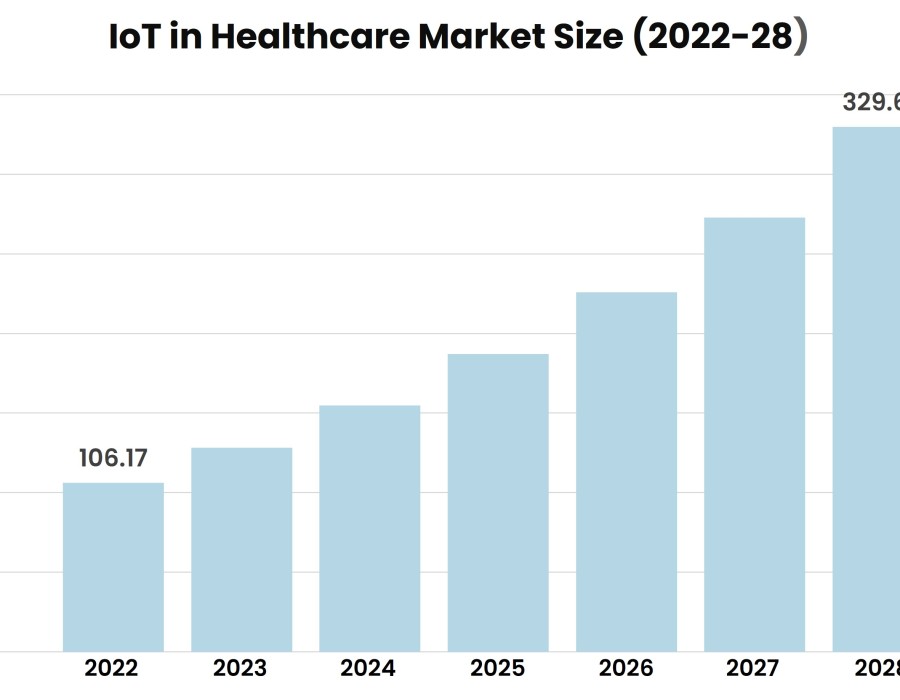According to Stratview Research, the IoT in healthcare market was estimated at USD 106.17 billion in 2022 and is likely to grow at a CAGR of 20.78% during 2023-2028 to reach USD 329.68 billion in 2028.
In the ever-evolving landscape of healthcare, the Internet of Things (IoT) has emerged as a transformative force, revolutionizing the delivery of care, enhancing patient outcomes, and driving operational efficiencies. From remote patient monitoring to smart hospital infrastructure, IoT technologies are reshaping every aspect of the healthcare ecosystem. In this article, we delve into the trends and insights shaping the IoT revolution in healthcare and explore the transformative potential of connected health solutions.
The Evolution of Connected Healthcare
Gone are the days of episodic care and paper-based records. Today, healthcare is becoming increasingly connected, with IoT devices and sensors generating vast amounts of data that can be leveraged to deliver proactive, personalized care. The IoT revolution in healthcare is driven by several key trends, each offering unique insights into the future of connected health.
Key Trends in IoT Healthcare
Remote Patient Monitoring: Remote patient monitoring (RPM) is a cornerstone of IoT healthcare, enabling healthcare providers to monitor patients' vital signs and health metrics remotely. With the proliferation of wearable devices and medical sensors, patients can now be monitored outside of traditional healthcare settings, allowing for early detection of health issues, timely interventions, and improved patient outcomes.
Telemedicine and Virtual Care: The rise of telemedicine and virtual care platforms has been accelerated by IoT technology, enabling healthcare providers to deliver care remotely via video conferencing, secure messaging, and remote diagnostics. Telemedicine offers convenience and accessibility, particularly for patients in rural or underserved areas, while reducing unnecessary hospital visits and minimizing the risk of exposure to infectious diseases.
Smart Hospital Infrastructure: IoT technology is transforming traditional hospitals into smart, connected environments, with sensors, beacons, and IoT-enabled devices embedded throughout the facility. Smart hospital infrastructure enables real-time asset tracking, environmental monitoring, and workflow optimization, enhancing operational efficiency, patient safety, and staff productivity.
Predictive Analytics and AI: The integration of IoT data with advanced analytics and artificial intelligence (AI) algorithms enables predictive analytics models that can forecast patient health outcomes, identify high-risk populations, and recommend personalized interventions. By analyzing large volumes of data in real-time, healthcare organizations can proactively manage patient health, prevent complications, and optimize resource allocation.
Insights into the IoT Healthcare Market
Rapid Growth and Adoption: The IoT healthcare market is experiencing rapid growth and adoption, driven by increasing demand for remote monitoring, telemedicine, and digital health solutions. According to market research, the global IoT healthcare market is projected to reach billions of dollars by [current year + 5], with a compound annual growth rate (CAGR) exceeding [X%].
Regulatory and Privacy Considerations: With the proliferation of IoT devices and data in healthcare, regulatory compliance and patient privacy have become top priorities for healthcare organizations and technology vendors. Compliance with regulations such as the Health Insurance Portability and Accountability Act (HIPAA) and the General Data Protection Regulation (GDPR) is essential to ensure the security and privacy of patient data.
Interoperability and Data Integration: As IoT devices and systems proliferate in healthcare, interoperability and data integration have emerged as significant challenges. Healthcare organizations are investing in interoperable platforms and standards to ensure seamless data exchange between disparate systems, enabling a unified view of patient health and facilitating collaborative care delivery.
Conclusion: Embracing the IoT Healthcare Revolution
As we navigate the IoT revolution in healthcare, it is clear that connected health solutions have the potential to revolutionize care delivery, improve patient outcomes, and drive operational efficiencies. By leveraging IoT technologies, healthcare organizations can deliver more personalized, proactive, and efficient care, transforming the healthcare experience for patients and providers alike. As the IoT healthcare market continues to evolve and innovate, the future of healthcare promises to be more connected, more intelligent, and ultimately, more compassionate






Comments